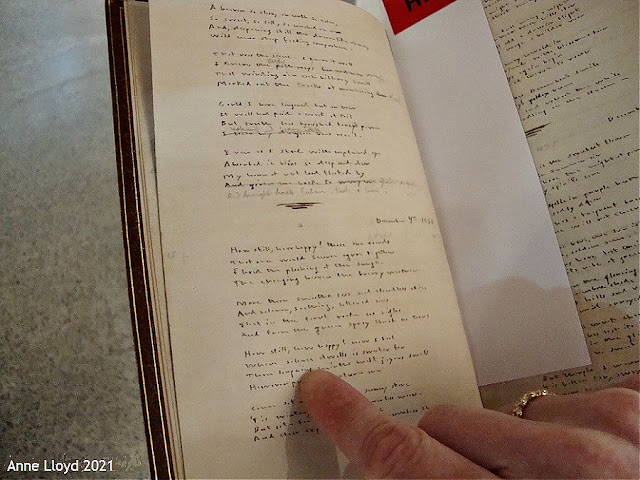My friend, Geri Meftah, of The Brontë Sisters blog, told me about The Honresfield Library collection and its Brontë items to be auctioned off via Sotheby's. One of her emails contained this information:
".... literary lovers
will be able to see items from the private collection at exhibitions in London,
Edinburgh and New York"
New York? That's well within a day trip for me, so my husband and I decided to
see if we could view the collection. I was particularly interested in seeing
the manuscript of Emily's poems, which would be in the Sotheby's NYC
display.
Display area
For many years it has been said such Emily papers were destroyed.
Well here were some and quite possibly they were among the very
papers that electrified Charlotte in the autumn of 1845 when she
read Emily's poems and resolved they would all seek publication.
These pages are arguably the most important Brontë manuscript there is, based
on the rarity of Emily's effects, the importance of her poetry and for being
the spur that ultimately brought us the Brontë sisters books.
At first I wondered since we were not gong to be bidding, we would not be let
in to see the collection. But that's wasn't the case at all. Sotheby's was very
welcoming. All one had to do was make an appointment via email. This we
did.
Sotheby's NYC, should be known as a free, cool thing to do in Manhattan.
You get to wonder about and look at all the items featured in up
coming autions. We saw three floors of priceless jewels, paintings and much
else. There's also a great Italian cafe on site!
The Brontë items on display in New York , besides Emily's poems, were Martha
Brown's copy of Wuthering
Heights and Agnes Grey
(signed by Patrick Brontë) , two letters of Branwell's, plus the family's 1816
Berwick Book of Birds, featured in the beginning of Jane Eyre.
When we were about to leave, I said to my husband " let's say goodbye to
the Brontë items." and we returned to the Honresfield display. I noticed a
young man looking it over. "Oh I thought how nice, another
fan". We had the area all to ourselves earlier, it was good to see
another enthusiast.
There was a tag in Emily's poems, placed like a bookmark. My husband wanted
to know its significance.
A young woman came by who was obviously connection to Sotheby's and he asked
her about it. Turned out it was something to do with the packing. Anyway
instead of leaving, we fell into conversation about the items with her and the
young man.
We all were excited about the items and chatted about them.
Then as she was speaking, the young woman reached into her pocket,took out a
key and opened the Brontë case.
Bronte display case
My shock was such, it was as if we had entered another dimension.
In fact I said aloud.
" She's opening the case!"
She then handed the young man the Berwick Book to look over .
I said" She's taking stuff out! "
I now realized I was in the presence of a for real bidder and a curator. I
later read the young man's business card. He was a representative
of a large, antiquarian book company with shops around the world.
After he looked the book over, the curator very kindly showed my husband
and I the Jane Eyre related pages and prints .
I was pinching myself already.
" May I hold that too? " I asked and she said" Certainly "









Thank you for posting this Geri! Tommrow will be two weeks and I'm still in shock, still trying to articulate the emotion!
BeantwoordenVerwijderenThe Brontë Sisters: It Happened At Sotheby'S. >>>>> Download Now
BeantwoordenVerwijderen>>>>> Download Full
The Brontë Sisters: It Happened At Sotheby'S. >>>>> Download LINK
>>>>> Download Now
The Brontë Sisters: It Happened At Sotheby'S. >>>>> Download Full
>>>>> Download LINK Rj